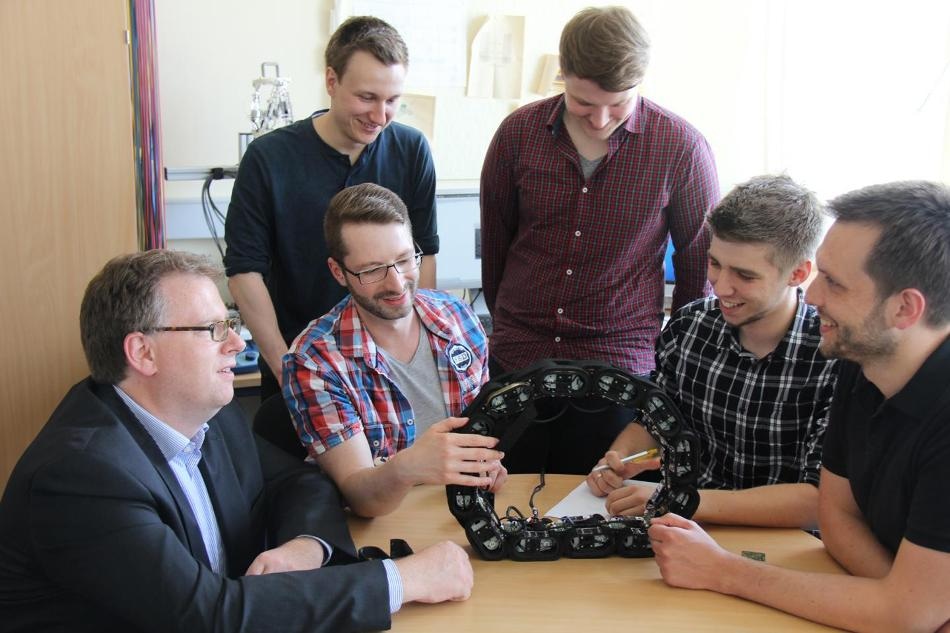Aug 2 2016
 Ourobot is the name of the new robot. It was developed by (from left) Prof. Dr. Axel Schneider, Johann Schröder, Adrian Gucze, Matthäus Wiltzok, Simon Beyer and Jan Paskarbeit. (CREDIT: Bielefeld University of Applied Sciences)
Ourobot is the name of the new robot. It was developed by (from left) Prof. Dr. Axel Schneider, Johann Schröder, Adrian Gucze, Matthäus Wiltzok, Simon Beyer and Jan Paskarbeit. (CREDIT: Bielefeld University of Applied Sciences)
As part of a research project, students at Bielefeld University of Applied Sciences have successfully developed "Ourobot". This research project was administered by a CITEC researcher and a professor at the Bielefeld University of Applied Sciences.
The robot was developed by Johann Schroeder, Adrian Gucze, Simon Beyer and Matthaeus Wiltzok, who are bachelor students in Computer Engineering at Bielefeld University of Applied Sciences.
The robot developed by the students looks like a bicycle chain, it has only twelve segments and is almost the size of a fist. There is a motor in each of the twelve segments. Professor Dr. Axel Schneider of the Bielefeld University of Applied Sciences and Jan Paskarbeit from Bielefeld University supervised this project. The robot was introduced through a new video.
The main feature that differentiates "Ourobot" from other robots is the presence of pressure sensors which help in detecting and overcoming obstacles. The robots name is inspired by an ancient Egyptian symbol, the Ouroboros, which depicts a serpent eating its own tail.
At the moment Ourobot can only move straight ahead and cannot manage curves yet, but its sensors can detect obstacles, such as a book, and can traverse them.
Jan Paskarbeit, Bielefeld University
The control mechanism that enables individual chain links to interact and roll over an obstacle is based on a complex mathematical task. "It is remarkable how the students have solved this", says Axel Schneider. The professor heads a large project at the Centre of Excellence that is aimed at developing a walking robot, "Hector", and the professor is also a co-opted member of CITEC.
"There is no concrete application for Ourobot at the moment. It is a feasibility study, meaning basic research", explains Schneider. This project work is exceptional because most of the bachelor's projects at the University of Applied Sciences are application-oriented. "However, this does not rule out fundamental research projects, quite the opposite, we integrate the students early into research projects", adds Schneider.
The partnership with the University continues with the master's degree in BioMechatronics, which is jointly offered by Bielefeld University and the Bielefeld University of Applied Sciences. Matthäus Wiltzok worked on the project and has registered for this course. He and his friends have been strongly influenced by robots and have decided to continue their work in this area.
The crowning moment for the team was the visit of the international robot conference (ICRA) in Stockholm that happened in May, 2016. The research paper on Ourobot was welcomed with great interest at the conference. The project Ourobot is still in the developing stage, and has a long way to go before it is concluded.
The supervisor of the project wishes to expand the present robot working in two dimensions into the third dimension, as Schneider explains.
We would like to develop a robot that actively changes its form, which can adapt to its environment like an amoeba, capable of stretching and shrinking again.
Dr. Axel Schneider, Professor, Bielefeld University
As a result, Ourobot will be able to overcome obstacles by different movements and will also be able to move through a narrow terrain. Different forms of the new 3D version of Ourobot that are akin to a snake or a ball have been designed by the team. The team has further more research to be done as a part of this project.